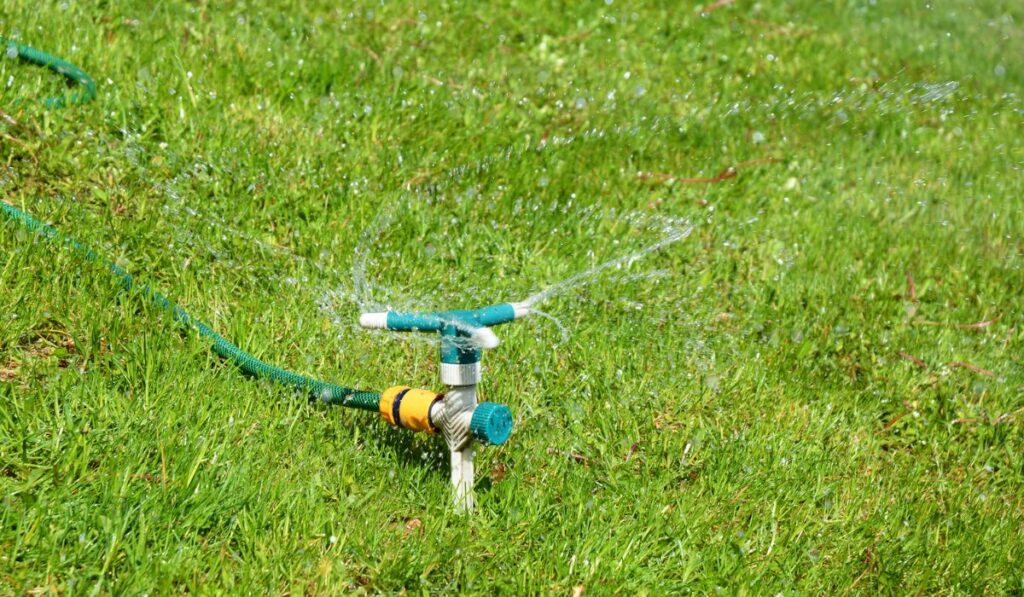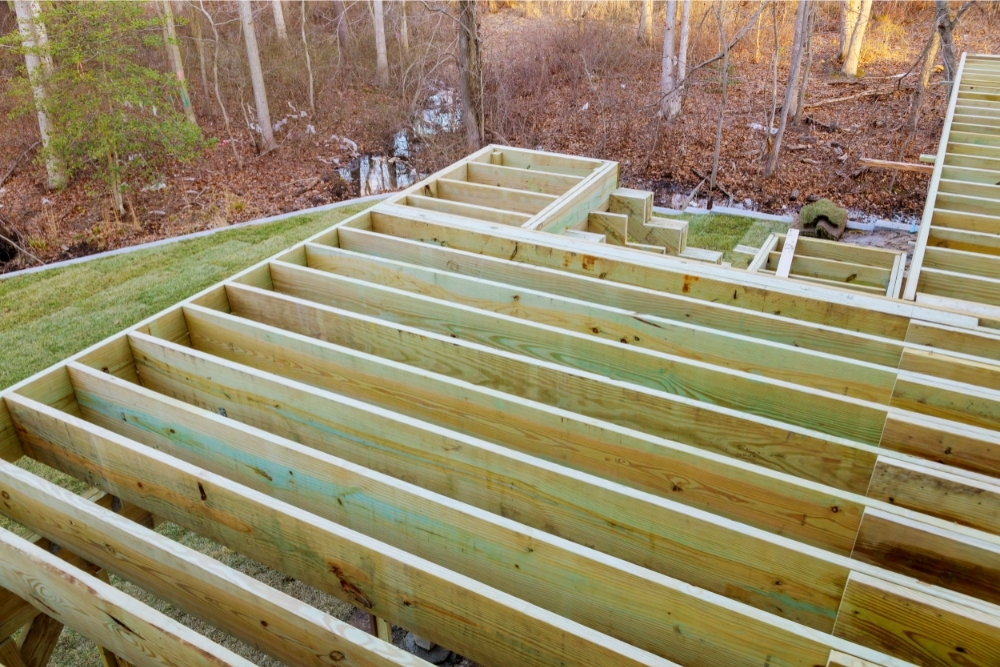Watering a Bermuda lawn haphazardly can have some severe side effects, while having the right schedule and knowing when and how much to water the grass can promote deeper and better root development. Plus, Bermuda grass has different water requirements in different seasons, making things tricky. So, what’s the best way to water Bermuda grass?
Bermuda grass needs ½-¾ inches of water per week in the spring and 1-1.25 inches per week in the summer. When the grass is dormant in the fall and winter, it only needs one inch of water every 2-3 weeks to prevent dehydration. Try watering the grass before sunrise, preferably between 5 and 7 am.
The right amount of water will ensure that you have a greener, fuller turf. Let’s take a closer look at how often and how much you need to water the grass in different seasons, the best time to water it, and the risk of giving too much water to your Bermuda turf.
What Is Bermuda Grass?

Bermuda grass is a warm-season grass that actively grows from late spring to summer. It’s relatively more sensitive to cold temperatures compared to other warm-season grasses like zoysia and cool-season grasses like fescue.
Bermuda grass (on Amazon) grows well in direct sunlight with sufficient drainage and is quite tolerant to humidity, salt, drought, and heat. Even though its roots stay within 6 inches of the ground, they can go as deep as 6 feet or more.
The resulting extensive system gives makes the grass more resilient to different environmental stresses when compared to other warm-season grasses.
How Often Should You Water Bermuda Grass?
Generally, you only need to give one inch of water to Bermuda grass lawns every week if there’s no rainfall. Try watering infrequently but deeply so that water reaches 4-6 inches deep (giving one inch of water in one watering session, instead of giving ¼ inches over four days). Doing so will encourage the grass roots to grow much deeper into the soil to find moisture.
However, you should stop watering when water starts to pool on the surface. If you’ve installed automatic sprinklers like these ones from Rainbird (on Amazon), make sure to test the settings and the control box. Place a rain gauge on the lawn, switch on the sprinklers, and check the output of the sprinkler to understand how long you need to run it.
Keep in mind that you can increase pre-set cycles in times of drought or simply switch off the whole system when there’s heavy rainfall. Remember that a lack of water can affect the color and growth of your lawn, but excessive water can kill the grass, especially if it’s poorly drained.
If you usually water the lawn using a manual sprinkler, use a gauge like this acrylic one from AcuRite (on Amazon) to ensure you don’t give more or less than one inch a week.
Try to plunge a screwdriver into the ground after watering. If it goes 4-6 inches into the ground, you know that you’ve given sufficient water. If it doesn’t, you can increase the amount of water you give. But don’t forget to stop watering if the water starts running on the surface.
Also, make sure that you adjust the watering schedule depending on the amount of rainfall in your area. If you see puddles of water because of heavy rain, you can skip irrigating the lawn that week. Once all the water is absorbed and the rain stops, you can continue following your normal watering schedule.
Watering in Spring
Bermuda grass needs less water in spring than it does in the hot summer months. However, you might need to give more water to newly sodded grass to speed up growth and strengthen the roots. In general, you should give ½-¾ inch of water to Bermuda grass in the spring.
An existing Bermuda turf doesn’t really need a lot of water in this season. However, if the leaf blades start to curl or turn yellow because of a lack of water, you can increase the amount to one inch every week.
Watering in Summer
In the summer, you should give the grass one inch of water per week. As the temperatures start to rise, there’s a higher chance of your Bermuda grass being affected by drought stress, which is why it’s important that you give it enough water.
Having a regular watering schedule in the summer can also help to prevent drought stress. While one inch per week is sufficient, don’t forget that you can adjust the amount of water and the irrigation frequency depending on the weather in your location and the type of soil on your lawn.
If you’re experiencing a heatwave or you live somewhere very hot (or in a desert climate), you might need to deeply water your grass 3-4 times a week to keep it green. However, it’s also important to mention here that increasing the length of the watering sessions is much better than adding more sessions.
Watering in the Fall
Bermuda grass stops growing at this time of the year, but you still need to water it every once in a while to prevent dehydration and drought stress. If your Bermuda grass becomes dormant early in the fall, you can simply cut down the frequency of irrigation.
Watering in Winters
Since Bermuda is a warm-season grass, it typically turns dormant in winters and the turf starts to turn brown. However, this doesn’t mean that you don’t need to water the grass; the roots require sufficient moisture to prevent dehydration even when the grass is dormant. It also helps avoid the stolons and rhizomes present near the surface from drying.
Of course, dormant grass doesn’t need as much water as grass that’s in its active growth stage. About ¼ to ½ inch of water every two to three weeks is enough for dormant Bermuda grass. And in case of frequent winter rain, you can just skip watering the lawn.
If it’s possible, water the dormant grass when the temperature is expected to go below 20 degrees. This is because wet soil freezes and keeps the temperature of the soil somewhere around 32 degrees, while dry soil lets the cool air penetrate and damage the roots.
How Long Does It Take to Water 1 Inch?
You now know that Bermuda needs roughly one inch of water. But how long do you need to run the sprinkler, and how can you make sure you don’t give more or less, especially if you’re using sprinklers? It’s quite easy and just requires five plastic cups. Just make sure that you use something heavy so that they don’t topple with the wind. And if you don’t have plastic cups, you can simply use five containers.
Place the cups in different parts of the lawn and switch on your sprinkler for an hour. Once the time is up, measure the depth of water in each cup. Now, take out the average depth of water that your sprinkler system applies by adding all of the depths and dividing the total by 5.
Finally, divide one inch by the calculated average to determine how long it’ll take to water the lawn. So, for instance, if the average depth comes out to be 0.5 inches per hour, it’ll take two hours to give one inch of water to the grass.
When’s the Best Time to Water Bermuda Grass?
You should water Bermuda grass in the morning, ideally before noon. The best time to water it is between 5 and 7 am, or just before sunrise. At this time, the weather is cool, so the water won’t evaporate even before it penetrates the soil, but once the sun is high up in the sky, it will burn off the excess water that can cause root rot.
Never water the grass late in the morning or in the afternoon since it robs the lawn of moisture, especially during the summers. Similarly, avoid watering the lawn at night since it can cause standing water which can encourage pests, diseases, and mold.
Watering in the evening seems like a suitable alternative to giving water in the morning, but you should avoid doing so. This is because watering so late in the day will cause excess water to collect in your yard, which again, causes plant diseases and mold, and attracts insects. This is also why you should make sure that you dry your lawn if there’s standing water present.
Can You Overwater Bermuda Grass?

Yes, it’s definitely possible to give too much water to your Bermuda grass, and you should definitely avoid doing so since it clogs the root, hinders root development, and retains moisture for prolonged periods.
An overwatered lawn is also more susceptible to pest attacks and fungal diseases. Some tell-tale signs of an overwatered lawn include brown patches, spongy ground, shallow roots, and excessive thatch.
Plus, overwatering causes problems with soil compaction, which, in turn, prevents the lawn from springing back up under foot traffic, and you get footprints on the lawn. Similarly, if you mow an overwatered lawn, you’ll end up with tire tracks on the lawn. Soil compaction due to overwatering also prevents oxygen from reaching the roots of the grass, inhibiting their growth and eventually killing them.
In addition, overwatering can result in lawn diseases. Fungi like brown patch fungi and dollar spot breed in wet conditions and are attracted to an overwatered turf with water puddles. These harmful fungi cause dead spots on the grass blades that make your lawn look ugly.
And finally, overwatering causes microbes to make their way into the soil, which hampers the growth and development of the roots. These bacteria thrive in moist conditions and cause the roots of the Bermuda grass to decay.








